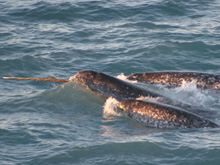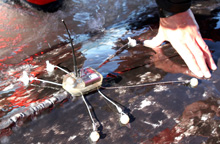Pod of narwhals, northern Canada, August 2005. Click image for larger view and image credit.
Satellite tag on a narwhal. Click image for larger view and image credit.
Narwhals As Oceanographers
Dr. Kristin Laidre, Polar Science Center
Applied Physics Lab, University of Washington
Dr. Mads Peter Heide-Jørgensen
Greenland Institute of Natural Resources
Narwhals spend most of their lives underwater and range over thousands of kilometers in arctic waters, features which make them difficult to study. A large part of the research has been spent on developing methods or instruments for scientific studies. Over the past 20 years, the development of microprocessors and satellites has offered new opportunities. Microprocessors are now so small and energy efficient that they can be used be collected without scientists having to be present, including during the dark and ice-covered winter.
Satellite tracking technology has been in rapid development over the past two decades. Satellite tags mounted on a whale transmit signals at frequent intervals which are picked up by polar orbiting satellites high above the globe. When several signals have been received by one satellite, the position of the animal can be determined. Many positions are received from a whale each day but not all are adequately accurate, even though location quality can be assessed. Satellite tags not only show where whales go but also what they did underwater. Information on diving, such as time beneath the surface, temperature, or light levels is transmitted in the form of coded numbers that are converted into data on dive activity and ocean features. Although it is only possible to instrument a few whales in a population with satellite transmitters, the method provides a straightforward method of recording where whales go every day. This method allows for the study of the movements and behavior of narwhals for up to 14 months, the longest a tag has stayed on a whale.
In the case of this project, narwhals will serve as biological autonomous sampling platforms and collect ocean temperature data at depths of over 1,500 meters. These data will be combined with traditional oceanographic data (collected from moorings and buoys) to better understand the temperature structure of Baffin Bay and perhaps initiate a novel monitoring system for Arctic waters.
References:
Heide-Jørgensen M. P., R Dietz, K. L. Laidre, P. Richard, J Orr, H. C. Schmidt. 2003. The migratory habits of narwhals. Canadian Journal of Zoology 81: 1298-1305.


















